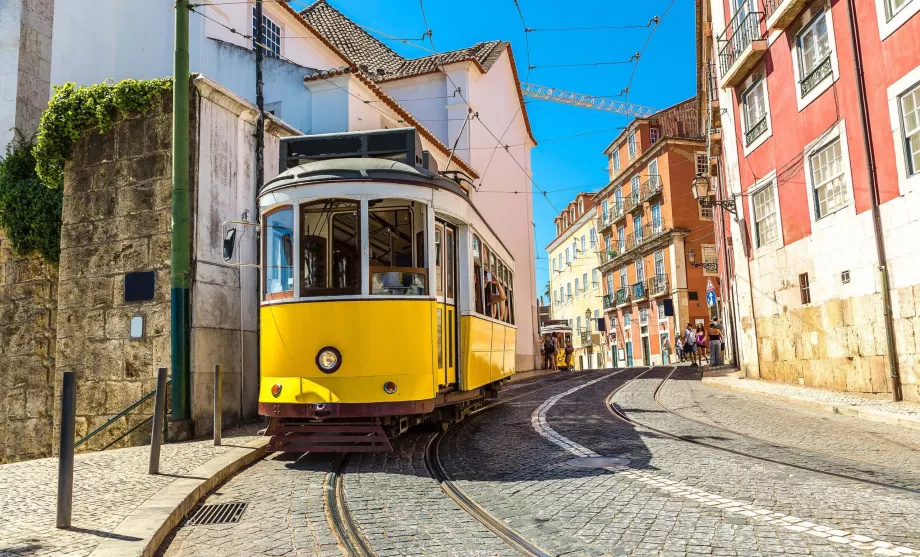Getting around Lisbon

Lisbon has a good public transport network including metro, buses, trams, trains, elevator and ferries on the Tejo River.
How much do tickets cost, where to buy them and how to use them? Where to find official information and is it worth taking a taxi around Lisbon? Find out in this chapter.
Find out the prices of hotels in Lisbon
The best tickets and apps for public transport
You may be able to get around the city centre on foot, but you'll definitely use public transport more than once, if only to ride the legendary yellow tram.
Lisbon's transport company Carris operates buses, trams, some ferries and the Santa Justa lift. The metro has a separate operator, as do the suburban trains and some ferries.
However, you can use the integrated Navegante (formerly "Viva Viagem") ticket for all modes of transport. You can transfer between all modes of transport without restrictions.
Navegante card - where to buy and how does it work?
The Navegante card can be bought at all metro and train stations and at selected retailers (typically newsagents across the city).
You can pay with coins or credit cards at vending machines.
Exactly how to use the Navegante card is explained below for each mode of transport.
The card itself costs 0,50 eur and is required to load additional tickets. You cannot purchase a physical ticket without first purchasing a Navegante card.
However, you can reload as many tickets as you like onto the card.
The other option is to use Zapping, i.e. load a selected amount of money onto the Navegante card, which will be charged gradually.
Ticket prices in Lisbon
All tickets and fares must be loaded on the Navegante card.
Detailed information and current ticket prices can be found on the website: navegante.pt/tarifario or carris.pt.
You can choose from three basic options.
- 24-hour tickets
- Time tickets for 60 minutes
- Zapping
Day or time tickets are valid only for metro or Carris buses and trams (yellow-green).
The term "Carris" means, in addition to the city buses and trams, also the ground-rail cable cars and the "Santa Justa" elevator.
Mobile app for buying tickets
There is no official ticketing app in Lisbon yet.
The transport company Carris operates mobile apps only for searching connections.
| Type | Price |
| Metro + Carris | 6,80 eur |
| Metro + Carris + Transtejo ferry | 9,80 eur |
| Metro + Carris + CP trains Also valid for travel to Sintra or Cascais |
10,80 eur |
| Price | |
| Transfer for 60 minutes | 1,80 eur |
| Type of transport | Price |
| Metro + Carris for 60 minutes | 1,61 eur |
| Ferry Barreiro - Terreiro do Paco | 2,75 eur |
| Ferry Cacilhas - Cais do Sodré | 1,43 eur |
| Ferry Trafaria - Belém | 1,40 eur |
| Ferry Montijo - Cais do Sodré | 3,10 eur |
| Ferry Seixal - Cais do Sodré | 2,75 eur |
| Train to Sintra or Cascais Valid for 120 minutes |
2 eur |
The last option is to buy tickets on board the bus or tram, which are only convenient if you don't plan to make more than one single journey around Lisbon. It is only worthwhile when travelling by bus, as a single tram ticket is more expensive than a single ticket loaded on a Navegante card.
Only cash can be used when buying a ticket from the driver. This is convenient if you are just passing through Lisbon and need to get between the station and the airport, for example.
For single tickets, there is no need to buy a Navegante card for €0.50. The ticket is always valid for the journey and is not a transfer ticket.
- 2,10 eur - bus
- 3,10 eur - tram
Is Zapping or a regular fare better?
Before you pay for your Navegante card, you can decide whether to buy a regular 60-minute fare, a 24-hour pass or load money on your card, i.e. use Zapping.
Zapping has no daily limit. It is therefore advantageous if you make less than 4 journeys and more than 1 journey per day within Lisbon. You can also use Zapping if you want to go to Sintra or Cascais.
When using zapping, you can load a minimum amount of 3 eur and a maximum amount of 40 eur onto the card.
Trams
Lisbon wouldn't be Lisbon without its classic historic yellow trams winding up, down, right, left through the city's narrow streets.
Lisbon has two types of trams: the historic yellow cars for which Lisbon is famous (called "Remodelado") and the modern classic trams ("Articulado").
On all other routes you will encounter the old yellow trams.
10 cheapest hotels in the historic centre
How and where to ride Lisbon's yellow tram?
Apart from line 15E, the iconic yellow trams run on all routes. Some are more popular, others less so (and therefore less crowded).
- Line 28E - the most popular route runs through the Alfama and Bairro Alto districts as well as through the centre of Lisbon itself. This route is by far the busiest and most crowded.
- Jízdní řád: carris.pt/28e
- Line 12E - a complementary route to line 28E, weaving through the most famous streets of the Alfama district, terminating in the central square of the Bairro Alto district. This route is also very busy.
- Jízdní řád: carris.pt/12e
- Line 25E - an interesting route from Cais do Sodre through the lower part of Bairro Alto and a pleasant alternative to the crowded routes 12E or 28E.
- Jízdní řád: carris.pt/25e
- Line 24E - a nice and relatively lightly used route running north through Bairro Alto.
- Jízdní řád: carris.pt/24e
- Line 18E - runs from Cais do Sodre to the Ajuda district in the west of the city and is the least touristy.
- Jízdní řád: carris.pt/18e
Trams stop at all stops.
Boarding is through the front door at the driver's side, alighting through the back door.
How much does a ticket cost and how do I use my Navegante card?
All historic tram lines have the same fares as other modes of transport.
So you can safely use 24-hour tickets or 60-minute transfer tickets or "Zapping" fares.
The Navegante card is only attached to the reader when boarding. You do not need to attach the card on exit.
You can also purchase a single ride ticket in cash from the driver for 3,10 eur.
For information on ticket prices, please visit: carris.pt.
Tips and tricks for riding the tram
All routes are beautiful, as trams on all lines weave through narrow streets with frequent single-track sections.
The most photogenically interesting lines are in the Alfama district (lines 12E and 28E).
It is on lines 12E and 28E that the biggest crowds of tourists are always found. Get on ideally at the final stops (preferably Martim Moniz) to fit on the tram at all.
Most people take the trams between 9:00 and 19:00.
The main lines run from about 5:30am to 11:30pm.
Metro
The metro in Lisbon has four lines, the most important being the Red (Vermelha), which goes to the airport and Oriente station, and the Green (Verde), which you transfer to at Alameda station from the Red line and go straight to the centre.
You can buy a Navegante card at each metro station to top up your day ticket (see above).
As the metro is the most common form of transport in the city, we break down the details in the Lisbon Metro chapter.
Buses
Where you can't get to by metro or tram, there are buses. Lisbon has a very extensive bus network, you can really get everywhere.
The vehicles are new and clean, the stops are well marked, only the ticket machines are a problem. You can usually only find them at metro stations, and you can only buy a single ride ticket from the bus driver for 2,10 eur. Day tickets are only sold by machines.
All bus stops are signposted, so be sure to press the stop button before getting off the bus and signal to the driver when you get on that you want to get on.
Most buses run from 6:30am to 11:30pm until midnight.
Detailed timetables: carris.pt.
Night buses
Night services are provided by lines 201 to 210, all of which depart from the central Cais do Sodré station in all directions of the city.
The lines run at intervals of 30-60 minutes.
How do I use my Navegante card on the bus?
The card is only attached to the reader when boarding. You do not use the card when you get off the bus.
Cable cars
In addition to the yellow trams, there are three funiculars that run through the hills of Lisbon.
The cable cars are very similar to the yellow trams, except that they run up steep hills and usually only make one stop.
Apart from being a tourist attraction, cable cars are great for overcoming the great difference in altitude.
Where do Lisbon cable cars run?
There are currently 3 cable cars in operation.
- Ascensor Glória (also known as line 51E) - the busiest cable car traverses the hill from Restauradores Street and Rossio Station to the Bairro Alto district
- Jízdní řád: carris.pt/gloria
- Ascensor Lavra (also known as line 52E) - the shortest and least busy cable car goes to São José Hospital near Rossio Square
- Jízdní řád: carris.pt/lavra
- Ascensor Bica (also known as line 53E) - starts near Cais do Sodré and goes up to Bairro Alto
- Jízdní řád: carris.pt/bica
Santa Justa lift
A somewhat atypical means of transport connected to the public transport network is a unique technical and architectural masterpiece - the Santa Justa elevator.
This will allow a quick journey between the great height difference in the city centre (from Áurea Street to Largo de Carmo).
The unmistakable structure, which resembles a tower (and it really is a tower), is recognizable at a glance.
Even the elevator ride is subject to a regular 24-hour ticket.
If you don't have one, you can buy a ticket for 6 eur, which is valid for 2 rides. You cannot buy a ticket for just 1 ride.
The lift runs at regular intervals of 14-16 minutes. To view the timetable, visit: carris.pt/santa-justa-lift.
Ferries
Whether you want to take a leisurely ride along the stunning Tejo estuary or head to the statue of Christ in Almada (across the river from Lisbon), which was the model for the more famous statue in Rio, you'll want to take the "Transtejo" ferry.
Transtejo boats sail on several lines.
The busiest routes run roughly every 10-15 minutes, while less busy lines run once every 30-60 minutes.
Official information and detailed timetables can be found on the website: ttsl.pt/passageiros.
How much do tickets cost?
Individual fares vary for different lines.
You can buy single fares at the dock or you can opt for cheaper fares through the so-called "zapping" on the Navegante card (detailed information above in the "Tickets" section).
An extended 24-hour ticket is valid on all ferries for 9,80 eur.
| Individual fares | "Zapping" fares | |
| Cais do Sodré - Cacilhas | 1,50 eur | 1,43 eur |
| Cais do Sodré - Seixal | 2,80 eur | 2,75 eur |
| Cais do Sodré - Montijo | 3,15 eur | 3,10 eur |
| Barreiro - Terreiro do Paco | 2,80 eur | 2,75 eur |
| Belém - Porto Brandao - Trafaria | 1,45 eur | 1,40 eur |
Trains
You won't make much use of the trains when moving around the city itself, but you will on trips outside Lisbon.
The most used route is the one to popular Sintra.
Trains to Sintra leave from Rossio station in the city centre (once every 20 minutes) and from Oriente, Entrecampos or Sete Rios stations (once every 10 minutes).
In total, the journey from Lisbon takes about 40 minutes and costs 2,40 eur when purchased at the station or online via cp.pt.
You can pay a more convenient fare 2 eur by Navegante card if you use the "zapping" payment, see information above.
On trains to both Sintra and Cascais you can use the extended 24-hour ticket for 10,80 eur.
Train timetables can be found on the Portuguese Railways website cp.pt.
Taxi
Taxis in Lisbon are quite cheap, and if you are travelling in more than one person at a time, a taxi may even be worth the price compared to public transport.
Especially popular here are the mobile apps Uber or Bolt, which can get you across the city cheaply at all hours of the day and night.
For example, Bolt or Uber from the city centre to the airport is based on current demand at 8 eur to 12 eur.
Any questions left?
If you have any questions or comments about the article...
3 comments
Hi, I don't quite understand what the Navigator card is all about.
Let me get this straight: I buy the card for 0,5€.
I charge it, for example with 15€ and I can use it on the metro, bus and tram during my stay (4 days) until I run out of credit and if I need it I can recharge it with 5€ minimum up to 40€ .... Is that how it works?
Thank you.

Yes, you can either have a loaded credit or purchase a 24-hour ticket. Always via the card shown, you cannot travel without it.
Hey. Hey. I'm planning a trip to Lisbon for 5 days.
I know I'm going to buy a Navegante card.
On the first day, I'll have a 24h tariff. Is it possible to switch to Zapping on the second day? I read below that it is not possible at one moment.
If I can, I will charge the card to 20€. I will only use 3€ when Zapping.
Can I switch again the next day to the tariff and the amount of 6,8€ is hit?
If I have a balance on the card when I go home, is there anywhere to get it back?
Thank you

Hi, I think switching is completely out of the question, or at least it's nowhere to be selected as an option. I'm here now and I'm zapping. If you need to switch, I might opt to buy a second card and there you'll have a second plan. As for returns, check out the dealer as mentioned in the article, there are FAQs and I think I read something about returns there.



Let me renew the question - was anyone in Lisbon with children? I'm trying to understand how kids have it with public transport fares, but I guess I'm an asshole.
Then try writing your age, you'll be smaller. 🤤
Oh, hey, bro :-) 16, 12, 9
Four-year-olds and older ride at full fare, unless you buy them a children's Lisboa Card.
Thanks